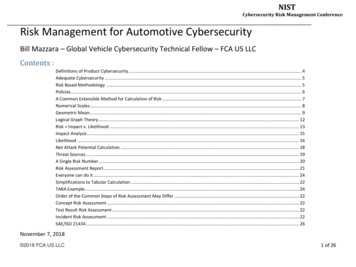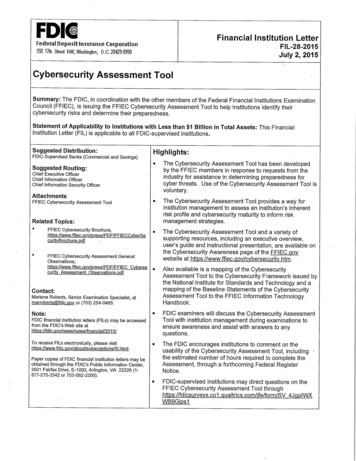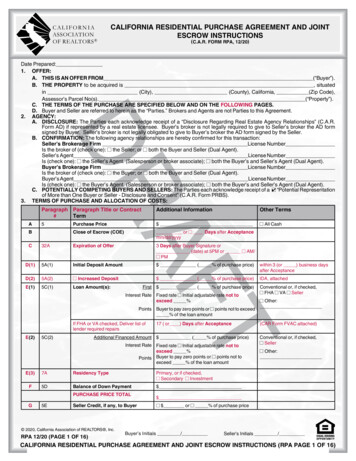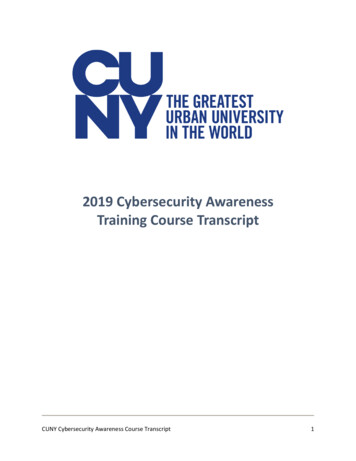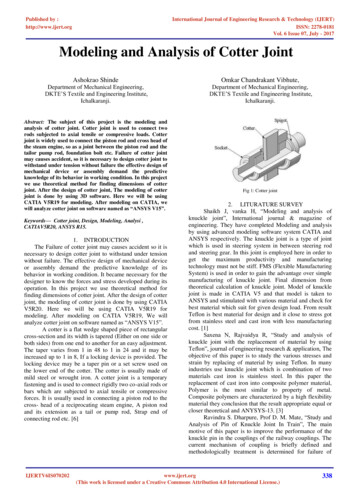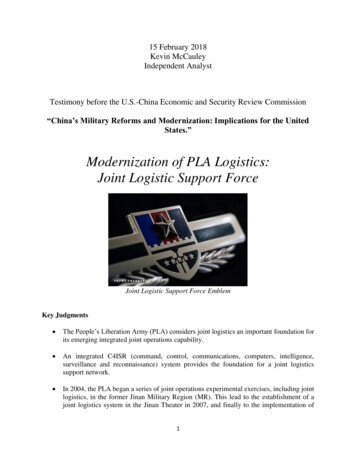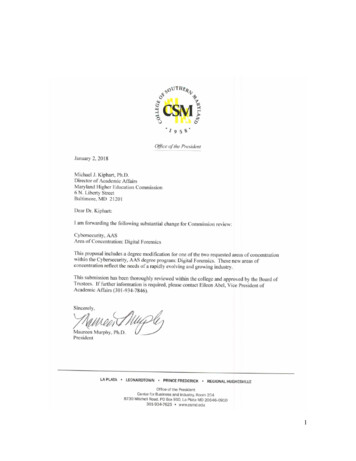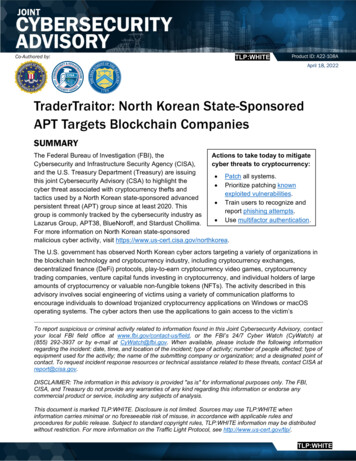
Transcription
Co-Authored by:TLP:WHITEProduct ID: A22-108AApril 18, 2022TraderTraitor: North Korean State-SponsoredAPT Targets Blockchain CompaniesSUMMARYActions to take today to mitigateThe Federal Bureau of Investigation (FBI), thecyber threats to cryptocurrency:Cybersecurity and Infrastructure Security Agency (CISA),and the U.S. Treasury Department (Treasury) are issuing Patch all systems.this joint Cybersecurity Advisory (CSA) to highlight the Prioritize patching knowncyber threat associated with cryptocurrency thefts andexploited vulnerabilities.tactics used by a North Korean state-sponsored advanced Train users to recognize andpersistent threat (APT) group since at least 2020. Thisreport phishing attempts.group is commonly tracked by the cybersecurity industry as Use multifactor authentication.Lazarus Group, APT38, BlueNoroff, and Stardust Chollima.For more information on North Korean state-sponsoredmalicious cyber activity, visit https://www.us-cert.cisa.gov/northkorea.The U.S. government has observed North Korean cyber actors targeting a variety of organizations inthe blockchain technology and cryptocurrency industry, including cryptocurrency exchanges,decentralized finance (DeFi) protocols, play-to-earn cryptocurrency video games, cryptocurrencytrading companies, venture capital funds investing in cryptocurrency, and individual holders of largeamounts of cryptocurrency or valuable non-fungible tokens (NFTs). The activity described in thisadvisory involves social engineering of victims using a variety of communication platforms toencourage individuals to download trojanized cryptocurrency applications on Windows or macOSoperating systems. The cyber actors then use the applications to gain access to the victim’sTo report suspicious or criminal activity related to information found in this Joint Cybersecurity Advisory, contactyour local FBI field office at www.fbi.gov/contact-us/field, or the FBI’s 24/7 Cyber Watch (CyWatch) at(855) 292-3937 or by e-mail at CyWatch@fbi.gov. When available, please include the following informationregarding the incident: date, time, and location of the incident; type of activity; number of people affected; type ofequipment used for the activity; the name of the submitting company or organization; and a designated point ofcontact. To request incident response resources or technical assistance related to these threats, contact CISA atreport@cisa.gov.DISCLAIMER: The information in this advisory is provided "as is" for informational purposes only. The FBI,CISA, and Treasury do not provide any warranties of any kind regarding this information or endorse anycommercial product or service, including any subjects of analysis.This document is marked TLP:WHITE. Disclosure is not limited. Sources may use TLP:WHITE wheninformation carries minimal or no foreseeable risk of misuse, in accordance with applicable rules andprocedures for public release. Subject to standard copyright rules, TLP:WHITE information may be distributedwithout restriction. For more information on the Traffic Light Protocol, see http://www.us-cert.gov/tlp/.TLP:WHITE
FBI CISA TreasuryTLP:WHITEcomputer, propagate malware across the victim’s network environment, and steal private keys orexploit other security gaps. These activities enable additional follow-on activities that initiatefraudulent blockchain transactions.The U.S. government previously published an advisory about North Korean state-sponsored cyberactors using AppleJeus malware to steal cryptocurrency: AppleJeus: Analysis of North Korea’sCryptocurrency Malware. The U.S. government has also previously published advisories about NorthKorean state-sponsored cyber actors stealing money from banks using custom malware: HIDDEN COBRA – FASTCash CampaignFASTCash 2.0: North Korea’s BeagleBoyz Robbing BanksThis advisory provides information on tactics, techniques, and procedures (TTPs) and indicators ofcompromise (IOCs) to stakeholders in the blockchain technology and cryptocurrency industry to helpthem identify and mitigate cyber threats against cryptocurrency.TECHNICAL DETAILSThreat UpdateThe U.S. government has identified a group of North Korean state-sponsored malicious cyber actorsusing tactics similar to the previously identified Lazarus Group (see AppleJeus: Analysis of NorthKorea’s Cryptocurrency Malware). The Lazarus Group used AppleJeus trojanized cryptocurrencyapplications targeting individuals and companies—including cryptocurrency exchanges and financialservices companies—through the dissemination of cryptocurrency trading applications that weremodified to include malware that facilitates theft of cryptocurrency. As of April 2022, North Korea’sLazarus Group actors have targeted various firms, entities, and exchanges in the blockchain andcryptocurrency industry using spearphishing campaigns and malware to steal cryptocurrency. Theseactors will likely continue exploiting vulnerabilities of cryptocurrency technology firms, gamingcompanies, and exchanges to generate and launder funds to support the North Korean regime.Tactics, Techniques and ProceduresIntrusions begin with a large number of spearphishing messages sent to employees of cryptocurrencycompanies—often working in system administration or software development/IT operations(DevOps)—on a variety of communication platforms. The messages often mimic a recruitment effortand offer high-paying jobs to entice the recipients to download malware-laced cryptocurrencyapplications, which the U.S. government refers to as "TraderTraitor."The term TraderTraitor describes a series of malicious applications written using cross-platformJavaScript code with the Node.js runtime environment using the Electron framework. The maliciousapplications are derived from a variety of open-source projects and purport to be cryptocurrencytrading or price prediction tools. TraderTraitor campaigns feature websites with modern designadvertising the alleged features of the applications (see figure 1).Page 2 of 14 Product ID: A22-108ATLP:WHITE
FBI CISA TreasuryTLP:WHITEFigure 1: Screenshot of CryptAIS websiteThe JavaScript code providing the core functions of the software is bundled with Webpack. Within thecode is a function that purports to be an “update,” with a name such as UpdateCheckSync(), thatdownloads and executes a malicious payload (see figure 2).The update function makes an HTTP POST request to a PHP script hosted on the TraderTraitorproject’s domain at either the endpoint /update/ or /oath/checkupdate.php. In recent variants, theserver’s response is parsed as a JSON document with a key-value pair, where the key is used as anAES 256 encryption key in Cipher Block Chaining (CBC) or Counter (CTR) mode to decrypt the value.The decrypted data is written as a file to the system’s temporary directory, as provided by theos.tmpdir() method of Node.js, and executed using the child process.exec() method ofNode.js, which spawns a shell as a child process of the current Electron application. The text “UpdateFinished” is then logged to the shell for the user to see.Observed payloads include updated macOS and Windows variants of Manuscrypt, a custom remoteaccess trojan (RAT), that collects system information and has the ability to execute arbitrarycommands and download additional payloads (see North Korean Remote Access Tool:COPPERHEDGE). Post-compromise activity is tailored specifically to the victim’s environment and attimes has been completed within a week of the initial intrusion.Page 3 of 14 Product ID: A22-108ATLP:WHITE
TLP:WHITEFBI CISA TreasuryFigure 2: Screenshot depicting the UpdateCheckSync() and supporting functions bundled d4480196831db4aa5f18 associated with DAFOMPage 4 of 14 Product ID: A22-108ATLP:WHITE
TLP:WHITEFBI CISA TreasuryIndicators of CompromiseDAFOMDAFOM purports to be a “cryptocurrency portfolio application.” A Mach-O binary packaged within theElectron application was signed by an Apple digital signature issued for the Apple Developer TeamW58CYKFH67. The certificate associated with Apple Developer Team W58CYKFH67 has beenrevoked. A metadata file packaged in the DAFOM application provided the URLhxxps://github[.]com/dafomdev for bug reports. As of April 2022, this page was unavailable.dafom[.]devInformation as of February 2022:IP Address: 45.14.227[.]58Registrar: NameCheap, Inc.Created: February 7, 2022Expires: February 7, 480196831db4aa5f18Tags: dropper macosName: DAFOM-1.0.0.dmgSize: 87.91 MB (92182575 bytes)MD5: c2ea5011a91cd59d0396eb4fa8da7d21SHA-1: b2d9ca7b6d1bbbe4864ea11dfca343b7e15597d8SHA-256: xWbecR5Faxzpf0MTokenAISTokenAIS purports to help “build a portfolio of AI-based trading” for cryptocurrencies. Mach-O binariespackaged within the Electron application contained an Apple digital signature issued for the AppleDeveloper Team RN4BTXA4SA. The certificate associated with Apple Developer TeamRN4BTXA4SA has been revoked. The application requires users to “register” an account by enteringan email address and a password to use its features. The malicious TraderTraitor code is a Node.jsfunction called UpdateCheckSync() located in a file named update.js, which is bundled in a filecalled renderer.prod.js, which is in an archive called app.asar. This function passes the emailaddress that the user provided and the system platform to the C2 server, decrypts the response usingAES 256 in CBC mode with the hardcoded initialization vector (IV) !@34QWer% 78TYui and a keyprovided in the response, then writes the decrypted data to a file and executes it in a new shell.tokenais[.]comInformation as of January 2022:IP Address: 199.188.103[.]115Page 5 of 14 Product ID: A22-108ATLP:WHITE
TLP:WHITEFBI CISA TreasuryRegistrar: NameCheap, Inc.Created: January 27, 2022Expires: January 27, 2babd062e3fd7e0b03Tags: dropper macosName: TokenAIS.app.zipSize: 118.00 MB (123728267 bytes)MD5: 930f6f729e5c4d5fb52189338e549e5eSHA-1: 8e67006585e49f51db96604487138e688df732d3SHA-256: d062e3fd7e0b03ssdeep:3145728:aMFJlKVvw4 zLruAsHrmo5Vvw4 zLruAsHrmob0dC/E:aUlKtw4 /r2HNtw4 /r2HnMCMCryptAISCryptAIS uses the same language as TokenAIS to advertise that it “helps build a portfolio of AI-basedtrading.” It is distributed as an Apple Disk Image (DMG) file that is digitally signed by an Apple digitalsignature issued for the Apple Developer Team CMHD64V5R8. The certificate associated with AppleDeveloper Team CMHD64V5R8 has been revoked. The application requires users to “register” anaccount by entering an email address and a password to use its features. The malicious TraderTraitorcode is a Node.js function called UpdateCheckSync() located in a file named update.js, which isbundled in a file called renderer.prod.js, which is in an archive called app.asar. This functionpasses the email address that the user provided and the system platform to the C2 server, decryptsthe response using AES 256 in CTR mode and a key provided in the response, then writes thedecrypted data to a file and executes it in a new shell.cryptais[.]comInformation as of August 2021:IP Address: 82.102.31.14Registrar: NameCheap, Inc.Created: August 2, 2021Expires: August 2, bbf9009b27743b2e5bTags: dropper macosName: CryptAIS[.]dmgSize: 80.36 MB (84259810 bytes)MD5: 4e5ebbecd22c939f0edf1d16d68e8490SHA-1: f1606d4d374d7e2ba756bdd4df9b780748f6dc98SHA-256: 009b27743b2e5bPage 6 of 14 Product ID: A22-108ATLP:WHITE
TLP:WHITEFBI CISA 8jmrvGqjL2hX6QklBmrZgkZjMz AlticGO was observed packaged as Nullsoft Scriptable Install System (NSIS) Windows executablesthat extracted an Electron application packaged for Windows. These executables contain a simplerversion of TraderTraitor code in a function exported as UpdateCheckSync() located in a file namedupdate.js, which is bundled in renderer.prod.js, which is in the app.asar archive. The functioncalls an external function located in a file node modules/request/index.js bundled inrenderer.prod.js to make an HTTP request to hxxps://www.alticgo[.]com/update/. OneAlticGO sample, ea4999b66703ad,instead contacts hxxps://www.esilet[.]com/update/ (see below for more information aboutEsilet). Some image resources bundled with the application included the CreAI Deck logo (see belowfor more information about CreAI Deck). The response is written to disk and executed in a new shellusing the child process.exec() method in Node.js. Unlike newer versions of TraderTraitor, thereis no mechanism to decrypt a payload.alticgo[.]comInformation as of August 2020:IP Address: 108.170.55[.]202Registrar: NetEarth One Inc.Created: August 8, 2020Expires: August 8, f33d976d8314cfd819Tags: dropper peexe nsisName: AlticGO.exeSize: 43.54 MB (45656474 bytes)MD5: 1c7d0ae1c4d2c0b70f75eab856327956SHA-1: f3263451f8988a9b02268f0fb6893f7c41b906d9SHA-256: spAU6JXnJ46X eC6cySihWVXCompilation timestamp: 2018-12-15 22:26:14 616ea4999b66703adTags: dropper peexe nsisName: AlticGO R.exeSize: 44.58 MB (46745505 bytes)MD5: 855b2f4c910602f895ee3c94118e979aPage 7 of 14 Product ID: A22-108ATLP:WHITE
TLP:WHITEFBI CISA TreasurySHA-1: ff17bd5abe9f4939918f27afbe0072c18df6db37SHA-256: RpWGwpAU6JXnJ46X eC6cySiICompilation timestamp: 2020-02-12 16:15:17 9f4e089f4b0914925Tags: dropper peexe nsisName: AlticGO.exeSize: 44.58 MB (46745644 bytes)MD5: 9a6307362e3331459d350a201ad66cd9SHA-1: 3f2c1e60b5fac4cf1013e3e1fc688be490d71a84SHA-256: PxeuLpAU6JXnJ46X eC6cySiGCompilation timestamp: 2020-02-12 16:15:17 UTCEsiletEsilet claims to offer live cryptocurrency prices and price predictions. It contains a simpler version ofTraderTraitor code in a function exported as UpdateCheckSync() located in a file named update.js,which is bundled in renderer.prod.js, which is in the app.asar archive. The function calls anexternal function located in a file node modules/request/index.js bundled in renderer.prod.jsto make an HTTP request to hxxps://www.esilet[.]com/update/. The response is written to diskand executed in a new shell using the child process.exec() method in Node.js. Unlike newerversions of TraderTraitor, there is no mechanism to decrypt a payload. Esilet has been observeddelivering payloads of at least two different macOS variants of f1bd03f06258c51b73eb40efa ce0451e4cd4205156.Page 8 of 14 Product ID: A22-108ATLP:WHITE
FBI CISA TreasuryTLP:WHITEFigure 3: Screenshot of the UpdateCheckSync() function in Esiletesilet[.]comInformation as of June 2020:IP Address: 104.168.98[.]156Registrar: NameSilo, LLCCreated: June 12, 2020Expires: June 12, 2021greenvideo[.]nlLikely legitimate but compromised. Information as of April 2022:IP Address: 62.84.240[.]140Registrar: FlexwebhostingCreated: February 26, 2018Expires: Unknowndafnefonseca[.]comLikely legitimate but compromised. Information as of June 2020:IP Address: 151.101.64[.]119Registrar: PublicDomainRegistryPage 9 of 14 Product ID: A22-108ATLP:WHITE
TLP:WHITEFBI CISA TreasuryCreated: August 27, 2019Expires: August 27, 2022haciendadeclarevot[.]comLikely legitimate but compromised. Information as of June 2020:IP Address: 185.66.41[.]17Registrar: cdmon, 10DENCEHISPAHARD, S.L.Created: March 2, 2005Expires: March 2, 2023sche-eg[.]orgLikely legitimate but compromised. Information as of June 2020:IP Address: 160.153.235[.]20Registrar: GoDaddy.com, LLCCreated: June 1, 2019Expires: June 1, 2022www.vinoymas[.]chLikely legitimate but compromised. Information as of June 2020:IP Address: 46.16.62[.]238Registrar: cdmon, 10DENCEHISPAHARD, S.L.Created: January 24, 2010Expires: Unknowninfodigitalnew[.]comLikely legitimate but compromised. Information as of June 2020:IP Address: 107.154.160[.]132Registrar: PublicDomainRegistryCreated: June 20, 2020Expires: June 20, 5b814e6775ec477598Tags: dropper macosName: Esilet.dmgSize: 77.90 MB (81688694 bytes)MD5: 53d9af8829a9c7f6f177178885901c01SHA-1: ae9f4e39c576555faadee136c6c3b2d358ad90b9SHA-256: 4e6775ec477598ssdeep:1572864:lffyoUnp5xmHVUTd GgNPjFvp4YEbRU7h8cvjmUAm4Du73X0unpXkU:lfqHBmHo BPj9CYEshLqcuAX0I0Page 10 of 14 Product ID: A22-108ATLP:WHITE
TLP:WHITEFBI CISA d03f06258c51b73eb40efaTags: trojan machoName: Esilet-tmpzpsb3Size: 510.37 KB (522620 bytes)MD5: 1ca31319721740ecb79f4b9ee74cd9b0SHA-1: 41f855b54bf3db621b340b7c59722fb493ba39a5SHA-256: 2lirFbpR9mJGpmNC2 Endpoints: p .php ce0451e4cd4205156Tags: trojan machoName: Esilet-tmpg7lppSize: 38.24 KB (39156 bytes)MD5: 9578c2be6437dcc8517e78a5de1fa975SHA-1: d2a77c31c3e169bec655068e96cf4e7fc52e77b8SHA-256: mhy/L9RBrny6yC2 Endpoints: hxxps://sche‐eg[.]org/plugins/top.php .php top.phpCreAI DeckCreAI Deck claims to be a platform for “artificial intelligence and deep learning.” No droppers for itwere identified, but the filenames of the below samples, win32.bin and darwin64.bin, match thenaming conventions used by other versions of TraderTraitor when downloading a payload. Both aresamples of Manuscrypt that contact hxxps://aideck[.]net/board.php for C2 using HTTP POSTrequests with multipart/form‐data Content-Types.creaideck[.]comInformation as of March 2020:IP Address: 38.132.124[.]161Registrar: NameCheap, Inc.Created: March 9, 2020Page 11 of 14 Product ID: A22-108ATLP:WHITE
TLP:WHITEFBI CISA TreasuryExpires: March 9, 2021aideck[.]netInformation as of June 2020:IP Address: 89.45.4[.]151Registrar: NameCheap, Inc.Created: June 22, 2020Expires: June 22, 338ed11fd1efc7dd36Tags: trojan peexeName: win32.binSize: 2.10 MB (2198684 bytes)MD5: 5d43baf1c9e9e3a939e5defd8f8fbd8dSHA-1: d5ff73c043f3bb75dd749636307500b60a436550SHA-256: d11fd1efc7dd36ssdeep: 24576:y3SY mpilation timestamp: 2020-06-23 06:06:35 15ccd7512b1e63957Tags: trojan machoName: darwin64.binSize: 6.44 MB (6757832 bytes)MD5: 8397ea747d2ab50da4f876a36d673272SHA-1: 48a6d5141e25b6c63ad8da20b954b56afe589031SHA-256: tRwwfs62sRAdNhEJNDvOL3OXl5zpF FqBNihzTvff:KIH1kEhI1LOJtm2spBPage 12 of 14 Product ID: A22-108ATLP:WHITE
FBI CISA TreasuryTLP:WHITEMITIGATIONSNorth Korean state-sponsored cyber actors use a full array of tactics and techniques to exploitcomputer networks of interest, acquire sensitive cryptocurrency-intellectual property, and gainfinancial assets. The U.S. government recommends implementing mitigations to protect criticalinfrastructure organizations as well as financial sector organizations in the blockchain technology andcryptocurrency industry. Apply defense-in-depth security strategy. Apply security principles—such as least accessmodels and defense-in-depth—to user and application privileges to help prevent exploitationattempts from being successful. Use network segmentation to separate networks into zonesbased on roles and requirements. Separate network zones can help prevent lateral movementthroughout the organization and limit the attack surface. See NSA’s Top Ten CybersecurityMitigation Strategies for strategies enterprise organizations should use to build a defense-indepth security posture.Implement patch management. Initial and follow-on exploitation involves leveraging commonvulnerabilities and exposures (CVEs) to gain access to a networked environment.Organizations should have a timely vulnerability and patch management program in place tomitigate exposure to critical CVEs. Prioritize patching of internet-facing devices and monitoredaccordingly for any malicious logic attacks.Enforce credential requirements and multifactor authentication. North Korean maliciouscyber actors continuously target user credentials, email, social media, and private businessaccounts. Organizations should ensure users change passwords regularly to reduce theimpact of password spraying and other brute force techniques. The U.S. governmentrecommends organizations implement and enforce multifactor authentication (MFA) to reducethe risk of credential theft. Be aware of MFA interception techniques for some MFAimplementations and monitor for anomalous logins.Educate users on social engineering on social media and spearphishing. North Koreanactors rely heavily on social engineering, leveraging email and social media platforms to buildtrust and send malicious documents to unsuspecting users. A cybersecurity aware workforceis one of the best defenses against social engineering techniques like phishing. User trainingshould include how to identify social engineering techniques and awareness to only open linksand attachments from trusted senders.Implement email and domain mitigations. Maintain awareness of themed emailssurrounding current events. Malicious cyber actors use current events as lure for potentialvictims as observed during the COVID-19 pandemic. Organizations should have a robustdomain security solution that includes leveraging reputation checks and closely monitoring orblocking newly registered domains (NRDs) in enterprise traffic. NRDs are commonlyestablished by threat actors prior to malicious engagement.o HTML and email scanning. Organizations should disable HTML from being used inemails and scan email attachments. Embedded scripts may be hard for an antivirusproduct to detect if they are fragmented. An additional malware scanning interfaceproduct can be integrated to combine potentially malicious payloads and send thepayload to the primary antivirus product. Hyperlinks in emails should also be scannedPage 13 of 14 Product ID: A22-108ATLP:WHITE
FBI CISA TreasuryTLP:WHITE and opened with precautionary measures to reduce the likelihood of a user clicking ona malicious link.Endpoint protection. Although network security is critical, devices mobility often meanstraveling and connecting to multiple different networks that offer varying levels of security. Toreduce the risk of introducing exposed hosts to critical networks, organizations should ensuremobile devices have installed security suites to detect and mitigate malware.Enforce application security. Application allowlisting enables the organization to monitorprograms and only allow those on the approved allowlist to execute. Allowlisting helps to stopthe initial attack, even if the user clicks a malicious link or opens a malicious attachment.Implement baseline rule sets, such as NSA’s Limiting Location Data Exposure guidance, toblock execution of unauthorized or malicious programs.o Disable macros in office products. Macros are a common method for executingcode through an attached office document. Some office products allow for thedisabling of macros that originate from outside of the organization, providing a hybridapproach when the organization depends on the legitimate use of macros. Windows specific settings can be configured to block internet-originatedmacros from running. This can be done in the Group Policy AdministrativeTemplates for each of the associated Office products (specifically Word, Exceland PowerPoint). Other productivity software, such as LibreOffice andOpenOffice, can be configured to set the Macro Security Level.Be aware of third-party downloads—especially cryptocurrency applications. North Koreanactors have been increasingly active with currency generation operations. Users shouldalways verify file downloads and ensure the source is from a reputable or primary (preferred)source and not from a third-party vendor. Malicious cyber actors have continuouslydemonstrated the ability to trojanize applications and gain a foothold on host devices.Create an incident response plan to respond to possible cyber intrusions. The plan shouldinclude reporting incidents to both the FBI and CISA—quick reporting can reduce the severityof incidents and provide valuable information to investigators. Contact information can befound below.CONTACTAll organizations should report incidents and anomalous activity to CISA 24/7 Operations Centerat report@cisa.gov or (888) 282-0870 and/or to the FBI via your local FBI field office or the FBI’s 24/7CyWatch at (855) 292-3937 or CyWatch@fbi.gov.DISCLAIMERThe information in this advisory is provided "as is" for informational purposes only. The FBI, CISA,and Treasury do not provide any warranties of any kind regarding this information or endorse anycommercial product or service, including any subjects of analysis.Page 14 of 14 Product ID: A22-108ATLP:WHITE
companies—often working in system administration or software development/IT operations (DevOps)—on a variety of communication platforms. The messages often mimic a recruitment effort and offer high-paying jobs to entice the recipients to download malware-laced cryptocurrency applications, which the U.S. government refers to as "TraderTraitor."
